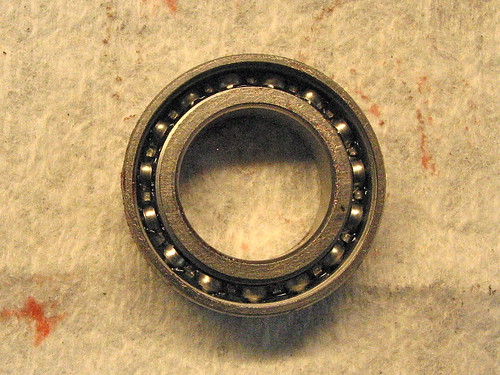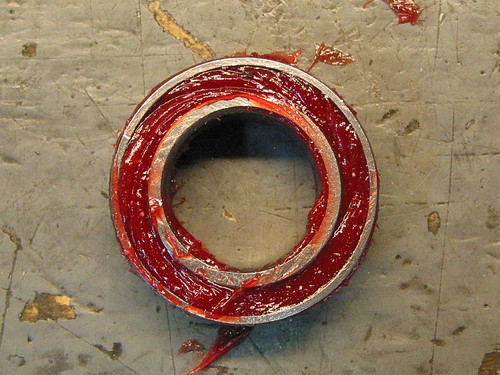By blackmountaincycles,
Filed under: Uncategorized
Grease, grease, grease, grease, grease, grease, grease, grease, grease. Grease is one of those words that when you say it enough becomes unfamiliar, like it just became a new word that you now need to look up. Semantic satiation – look it up. Semantic satiation is actually a pretty nifty phrase.
Grease is also something that seems to be used sparingly where it is needed most. Cartridge bearings are everywhere on a bike these days. Pretty much every part that rotates has a cartridge bearing, even parts that really don’t spin get cartridge bearings (headset and Avid Ultimate v-brakes). But the parts that do spin get judicious use of cartridge bearings – hubs, bottom brackets, pedals.
Cartridge bearings, because of their double seals feel like they have a lot of drag when you spin them in your fingers. To combat this, bearing manufacturers only fill the bearing with a small amount of grease, enough so the bearing still turns easy in your fingers, but has a modicum of lubrication for the bearings. The problem with this small amount of grease is that, under those seals, there is a large volume of empty space. Even though the cartridge bearing has those two heavy seals, that is not enough to keep water and dirt out. Water and dirt have amazing tenacity to get into any empty cavity.
It is not uncommon for a new part made with cartridge bearings to start feeling rough after a short period of time, or after one rain ride. I’ve replaced plenty of external bottom brackets and hub bearings that failed too soon. What can you do to increase bearing life?
First, make sure there the bearings are adjusted with no excess pre-load. Too often Shimano external bottom brackets are overloaded with too much pre-load. That little pre-load bolt on the left crankarm is only to remove the left-to-right movement of the crankarms, not to hold the crankarm on like some believe.
Second, pry off those seals and fill that bearing with grease. Sure it’s not going to spin as freely in your fingers, but then your fingers aren’t going to be pedaling your bike, your legs are. And your legs aren’t going to feel a few grams of added grease.
If you have a new bike, it’s not easy, or sometimes convenient, to go through all the bearings and fill your bearings with grease. It is easy when bearings are being replaced to add grease. Fill that cavity. I do it with every bearing I replace. I don’t think the type of grease is important. Personally, I use red grease, but sometimes I use green grease and other times, I might use a creme colored grease. When you pry the seal off, it’s important to use a sharp tool, but not so sharp you cut the seal. You also don’t want to bend the seal since the seal is typically a synthetic rubber covered metal ring. I use a box cutter (usually always somewhat dull) because the blade is broad and tougher than an X-Acto knife (which have easily broken tips). I usually pry off from the inner side and from there, fill each side with as much grease as it can possibly hold, spin the bearing a few times to get the grease in all the nooks and cranies. Then I loosely set both seals on top of the grease and press the both seals in to place at the same time, further filling the bearing. Any grease that doesn’t fit, will purge out as the seal snaps in place.
There, now you have a bearing full of grease. As anyone knows, 100% full is 100% full, no room for anything else. New bearings that are only about 50% full of grease leave 50% for contaminates to fill the rest of the space. The other thing I do is smear a bit of grease on the outside of the bearing before installing any extra shields or caps. This acts as an additional barrier for water and other contaminants to not get in to the bearing.
This is a new bearing for a WTB Laser Disc hub.
This is the other side of that same bearing. See how this side has a bit of grease where the other side has even less grease? That’s a bearing just begging to fail from contamination.
This is that same bearing now full of grease before the seals are reinstalled.
Back in the ’80s, WTB introduced a concept they called Grease Guard™. With this system, the inner shield is removed and replaced by a barrier that allows grease to fill only the bearing and from the inside out, purge the old grease out through the seal (if grease, with his higher viscosity can escape, imaging what water with almost no viscosity can do) after being pumped through a port with a Dualco grease gun. You can read more about Grease Guard™ on the Cunningham Bikes website.
New bearings in a 27 year old Steve Potts frame with new grease that has been purged to fill the bearing.
(What’s playing: The Black Keys Set You Free)
Next »
Wednesday WITS…
Wednesday WITS…





You mentioned and showed red grease. Which brand is that?
The red stuff is ProGold EPX.
It's not just cartridge bearings. Every new pair of MKS pedals I've bought come from the factory with only the barest excuse of grease. As a result (before I realized this) they felt rough and even failed prematurely. Now I rebuild them as a matter of course, applying a generous amount of grease, and they seem to last forever.
The non-drive side rear hub bearings seem to be going bad often these days. I have attributed this to the rear disc rotor transferring heat to the bearings and grease, speeding up wear. Haven't noticed it so much on the front in my experience.
Also, traveling with your bike on a rack, say on a rainy or cold day, can cool the bike's frame and create a vacuum and suck moisture/humidity in through bearing seals. I think Charlie Cunningham told me that.
What about grease shear with the cavity being filled 100% w/grease?
Off the cuff, with no engineering background to back this up, there will be a higher than optimal shear in a fully packed bearing. Ideally, there should be some space inside the bearing. And ideally, regular service of bearings (cartridge or cup & cone) would solve all these problems. However, most folks want to ride their bike into the dirt and then address service only when it's needed. For these, I think filling the bearing will give them the longest service intervals.
Which brand is the white grease in the BB of last photo?
It is Finish Line grease w/ Teflon®